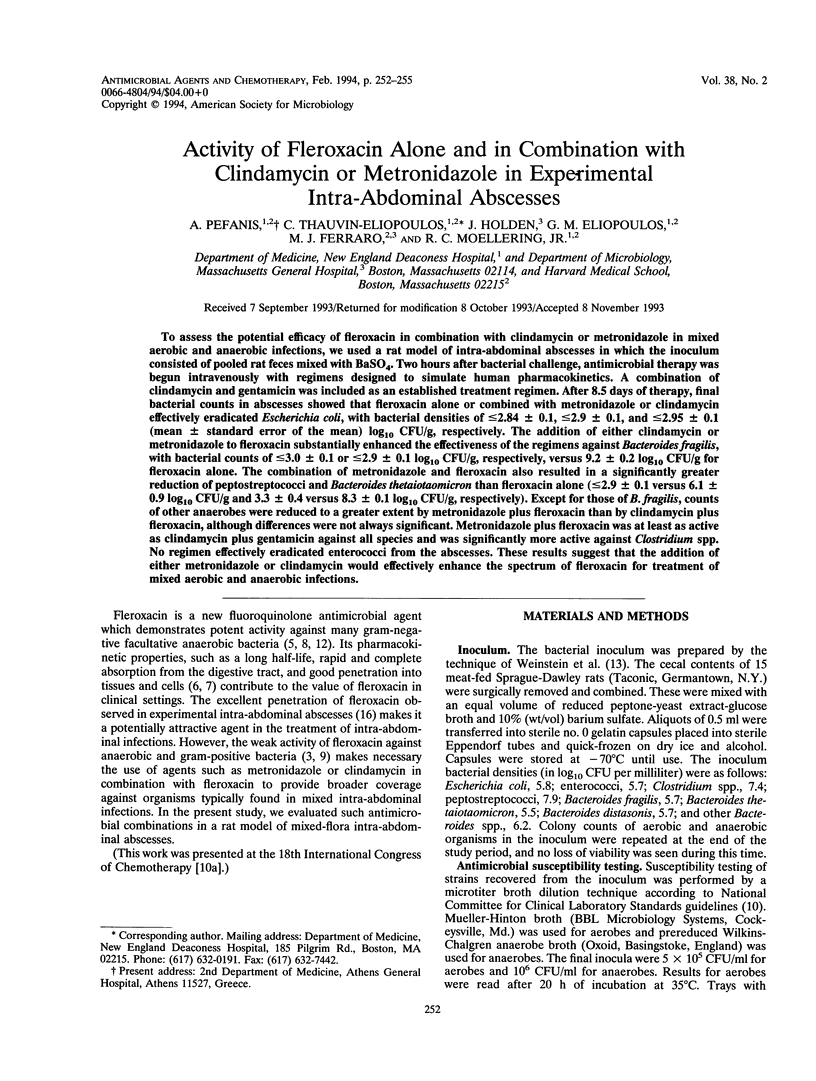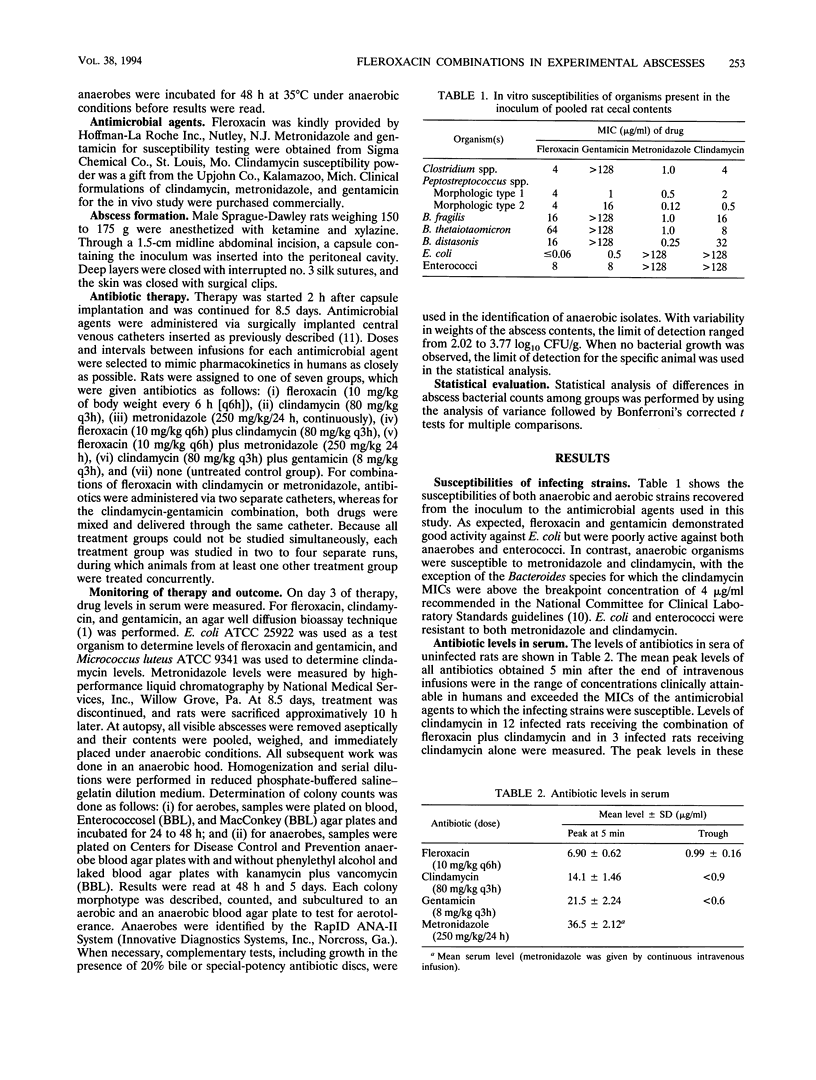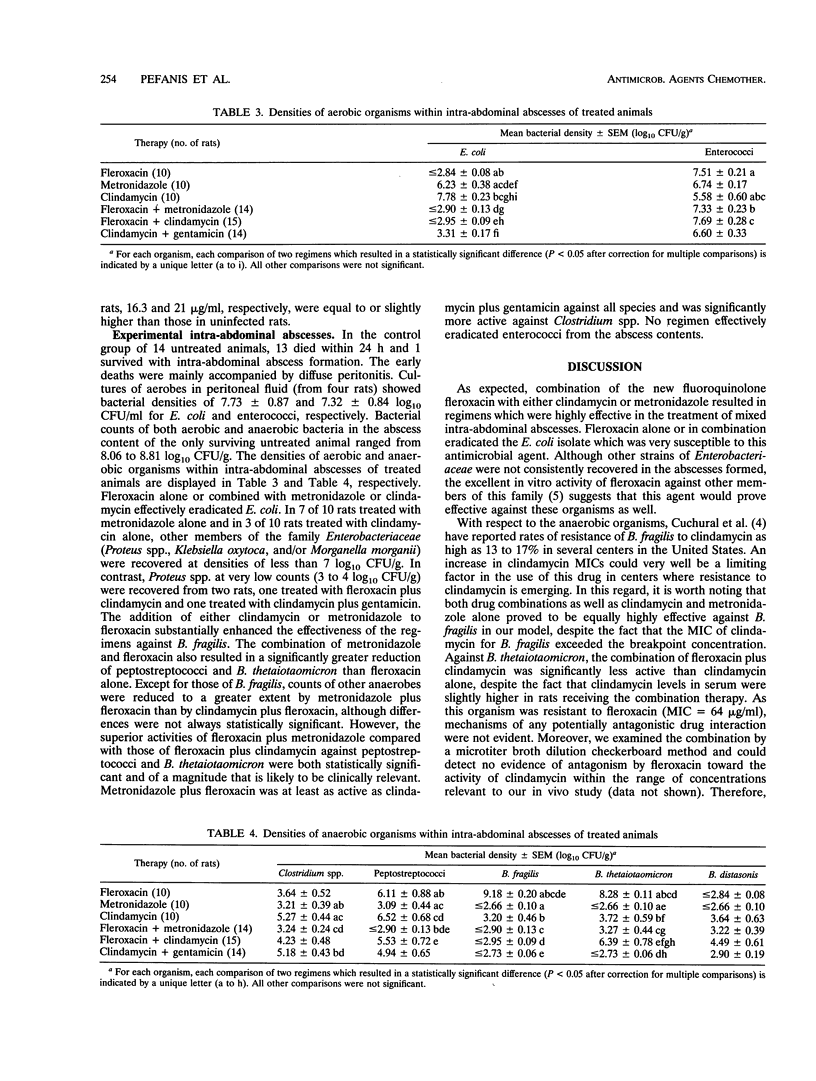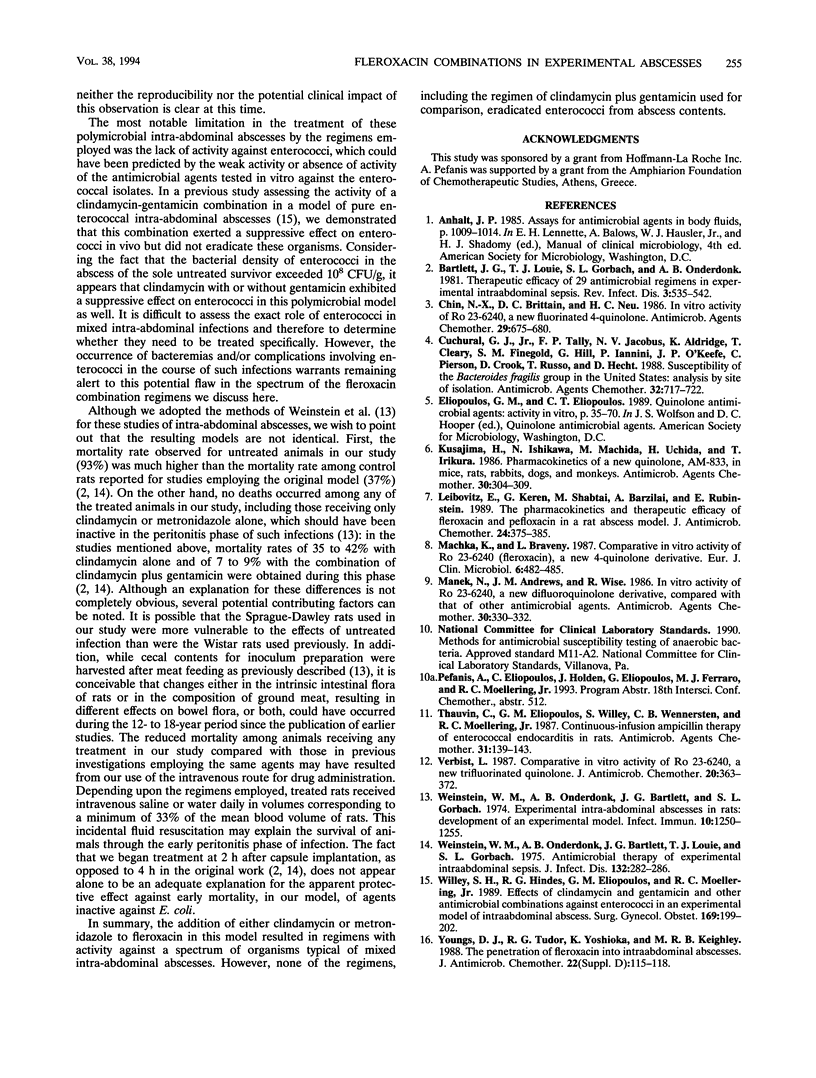Abstract
To assess the potential efficacy of fleroxacin in combination with clindamycin or metronidazole in mixed aerobic and anaerobic infections, we used a rat model of intra-abdominal abscesses in which the inoculum consisted of pooled rat feces mixed with BaSO4. Two hours after bacterial challenge, antimicrobial therapy was begun intravenously with regimens designed to stimulate human pharmacokinetics. A combination of clindamycin and gentamicin was included as an established treatment regimen. After 8.5 days of therapy, final bacterial counts in abscesses showed that fleroxacin alone or combined with metronidazole or clindamycin effectively eradicated Escherichia coli, with bacterial densities of < or = 2.84 +/- 0.1, < or = 2.9 +/- 0.1, and < or = 2.9 +/- 0.1 (mean +/- standard error of the mean) log10 CFU/g, respectively. The addition of either clindamycin or metronidazole to fleroxacin substantially enhanced the effectiveness of the regimens against Bacteroides fragilis, with bacterial counts of < or = 3.0 +/- 0.1 or < or = 2.9 +/- 0.1 log10 CFU/g, respectively, versus 9.2 +/- 0.2 log10 CFU/g for fleroxacin alone. The combination of metronidazole and fleroxacin also resulted in a significantly greater reduction of peptostreptococci and Bacteroides thetaiotaomicron than fleroxacin alone (< or = 2.9 +/- 0.1 versus 6.1 +/- 0.9 log10 CFU/g and 3.3 +/- 0.4 versus 8.3 +/- 0.1 log10 CFU/g, respectively). Except for those of B. fragilis, counts of other anaerobes were reduced to a greater extent by metronidazole plus fleroxacin than by clindamycin plus fleroxacin, although differences were not always significant. Metronidazole plus fleroxacin was at least as active a clindamycin plus gentamicin against all species and was significantly more active against Clostridium spp. No regimen effectively eradicated enterococci from the abscesses. These results suggest that the addition of either metronidazole or clindamycin would effectively enhance the spectrum of fleroxacin for treatment of mixed aerobic and anaerobic infections.
Full text
PDF



Selected References
These references are in PubMed. This may not be the complete list of references from this article.
- Bartlett J. G., Louie T. J., Gorbach S. L., Onderdonk A. B. Therapeutic efficacy of 29 antimicrobial regimens in experimental intraabdominal sepsis. Rev Infect Dis. 1981 May-Jun;3(3):535–542. doi: 10.1093/clinids/3.3.535. [DOI] [PubMed] [Google Scholar]
- Chin N. X., Brittain D. C., Neu H. C. In vitro activity of Ro 23-6240, a new fluorinated 4-quinolone. Antimicrob Agents Chemother. 1986 Apr;29(4):675–680. doi: 10.1128/aac.29.4.675. [DOI] [PMC free article] [PubMed] [Google Scholar]
- Cuchural G. J., Jr, Tally F. P., Jacobus N. V., Aldridge K., Cleary T., Finegold S. M., Hill G., Iannini P., O'Keefe J. P., Pierson C. Susceptibility of the Bacteroides fragilis group in the United States: analysis by site of isolation. Antimicrob Agents Chemother. 1988 May;32(5):717–722. doi: 10.1128/aac.32.5.717. [DOI] [PMC free article] [PubMed] [Google Scholar]
- Kusajima H., Ishikawa N., Machida M., Uchida H., Irikura T. Pharmacokinetics of a new quinolone, AM-833, in mice, rats, rabbits, dogs, and monkeys. Antimicrob Agents Chemother. 1986 Aug;30(2):304–309. doi: 10.1128/aac.30.2.304. [DOI] [PMC free article] [PubMed] [Google Scholar]
- Leibovitz E., Keren G., Shabtai M., Barzilai A., Rubinstein E. The pharmacokinetics and therapeutic efficacy of fleroxacin and pefloxacin in a rat abscess model. J Antimicrob Chemother. 1989 Sep;24(3):375–385. doi: 10.1093/jac/24.3.375. [DOI] [PubMed] [Google Scholar]
- Machka K., Braveny I. Comparative in vitro activity of RO 23-6240 (fleroxacin), a new 4-quinolone derivative. Eur J Clin Microbiol. 1987 Aug;6(4):482–485. doi: 10.1007/BF02013116. [DOI] [PubMed] [Google Scholar]
- Manek N., Andrews J. M., Wise R. In vitro activity of Ro 23-6240, a new difluoroquinolone derivative, compared with that of other antimicrobial agents. Antimicrob Agents Chemother. 1986 Aug;30(2):330–332. doi: 10.1128/aac.30.2.330. [DOI] [PMC free article] [PubMed] [Google Scholar]
- Thauvin C., Eliopoulos G. M., Willey S., Wennersten C., Moellering R. C., Jr Continuous-infusion ampicillin therapy of enterococcal endocarditis in rats. Antimicrob Agents Chemother. 1987 Feb;31(2):139–143. doi: 10.1128/aac.31.2.139. [DOI] [PMC free article] [PubMed] [Google Scholar]
- Verbist L. Comparative in-vitro activity of Ro 23-6240, a new trifluorinated quinolone. J Antimicrob Chemother. 1987 Sep;20(3):363–372. doi: 10.1093/jac/20.3.363. [DOI] [PubMed] [Google Scholar]
- Weinstein W. M., Onderdonk A. B., Bartlett J. G., Gorbach S. L. Experimental intra-abdominal abscesses in rats: development of an experimental model. Infect Immun. 1974 Dec;10(6):1250–1255. doi: 10.1128/iai.10.6.1250-1255.1974. [DOI] [PMC free article] [PubMed] [Google Scholar]
- Weinstein W. M., Onderdonk A. B., Bartlett J. G., Louie T. J., Gorbach S. L. Antimicrobial therapy of experimental intraabdominal sepsis. J Infect Dis. 1975 Sep;132(3):282–286. doi: 10.1093/infdis/132.3.282. [DOI] [PubMed] [Google Scholar]
- Willey S. H., Hindes R. G., Eliopoulos G. M., Moellering R. C., Jr Effects of clindamycin and gentamicin and other antimicrobial combinations against enterococci in an experimental model of intra-abdominal abscess. Surg Gynecol Obstet. 1989 Sep;169(3):199–202. [PubMed] [Google Scholar]
- Youngs D. J., Tudor R. G., Yoshioka K., Keighley M. R. The penetration of fleroxacin into intra-abdominal abscesses. J Antimicrob Chemother. 1988 Oct;22 (Suppl 500):115–118. doi: 10.1093/jac/22.supplement_d.115. [DOI] [PubMed] [Google Scholar]


